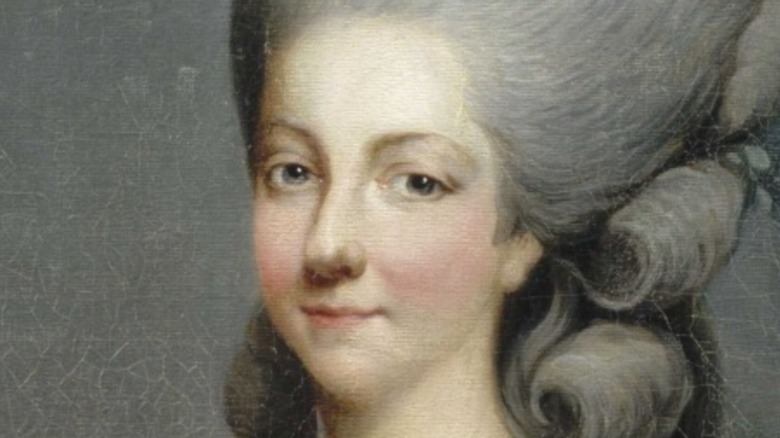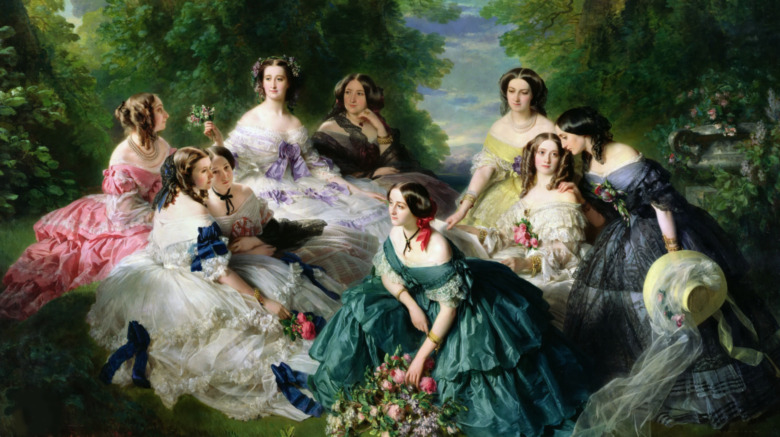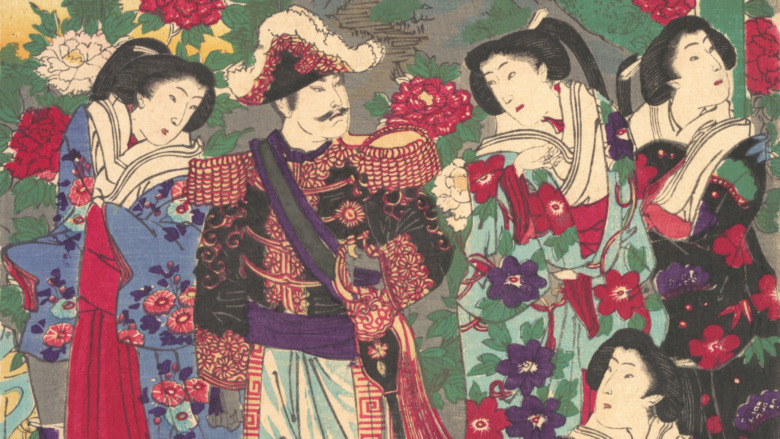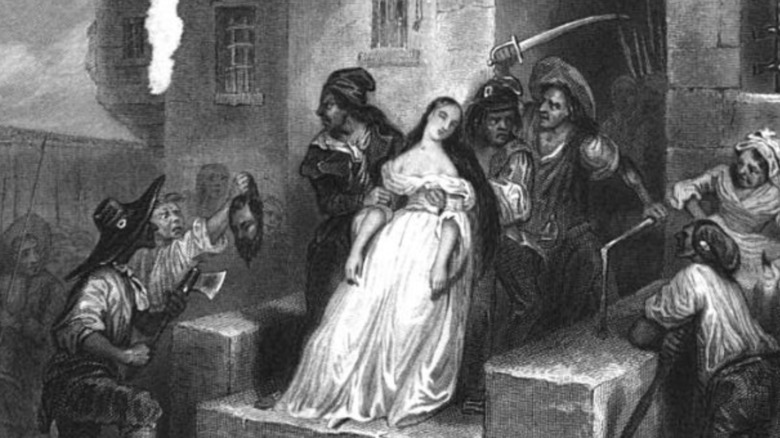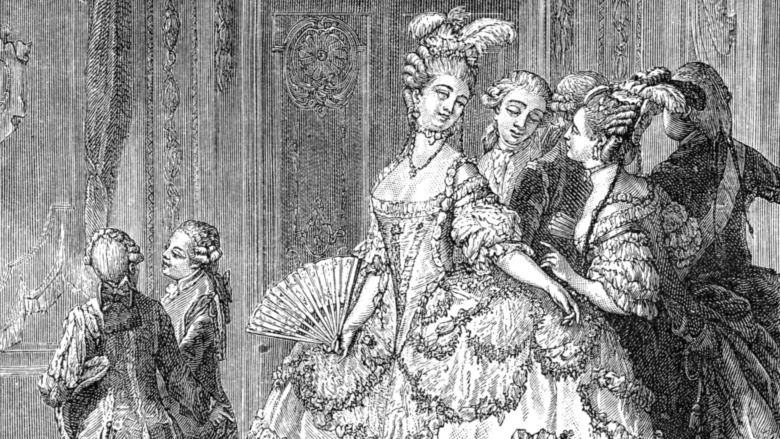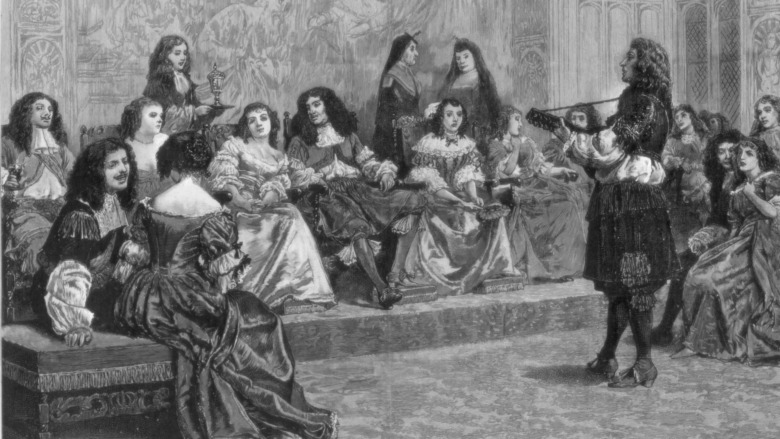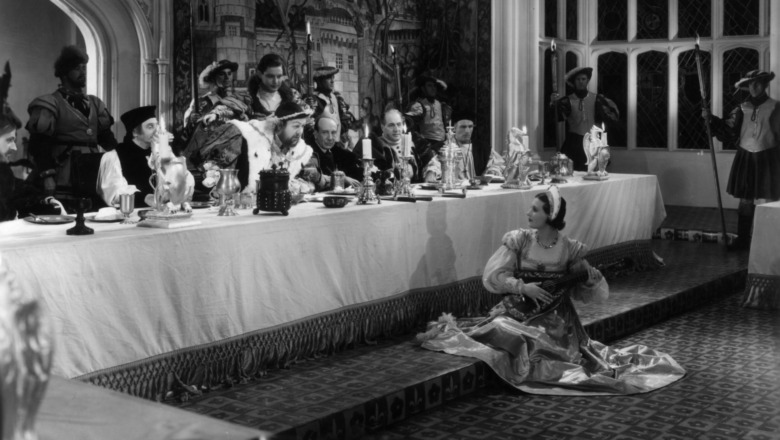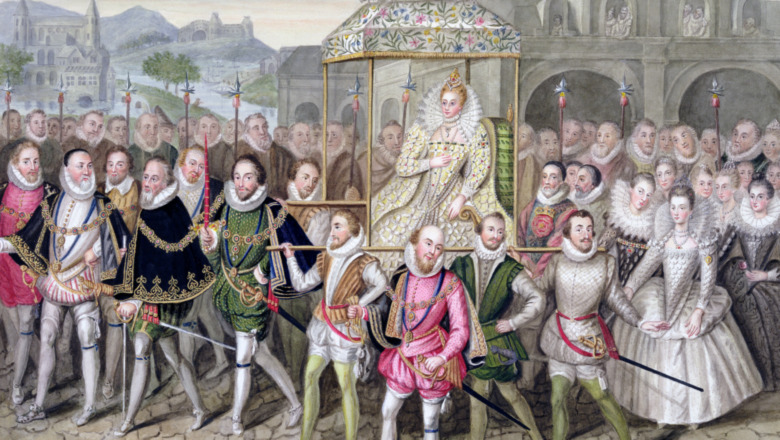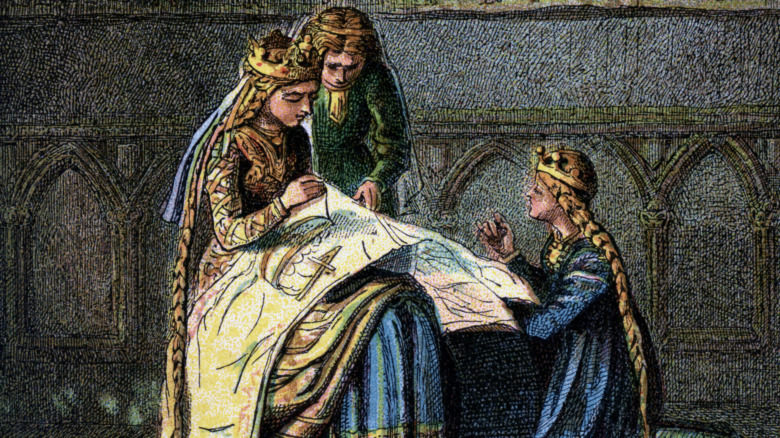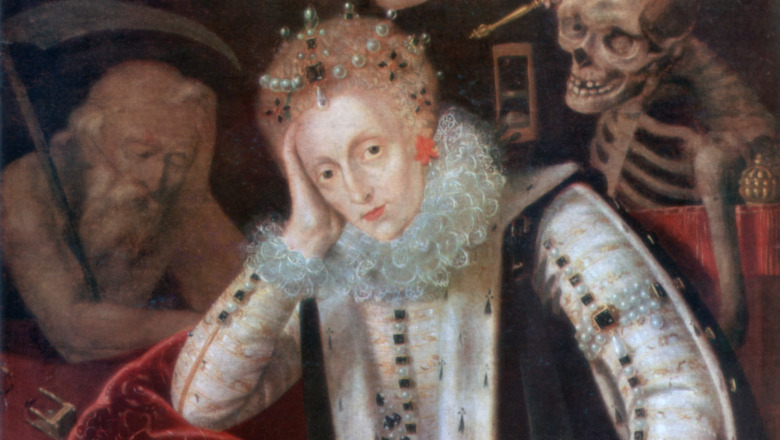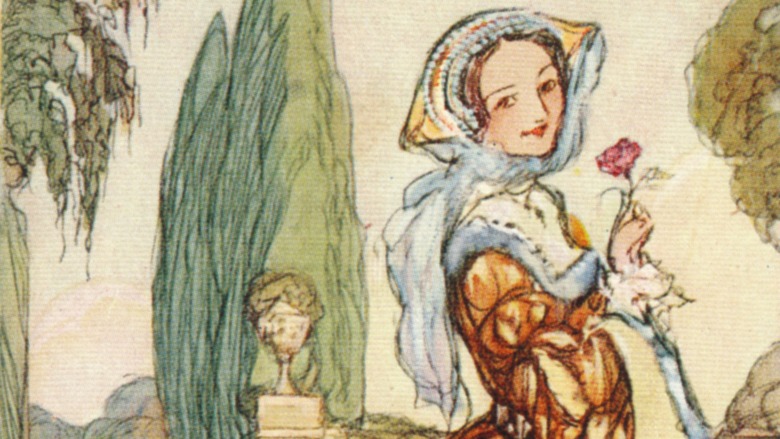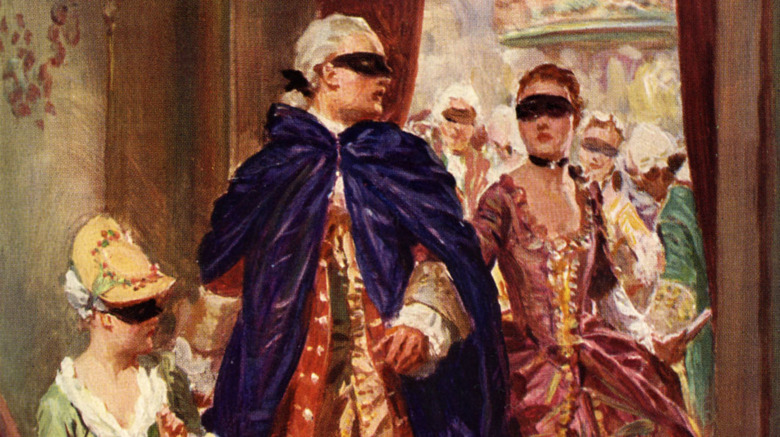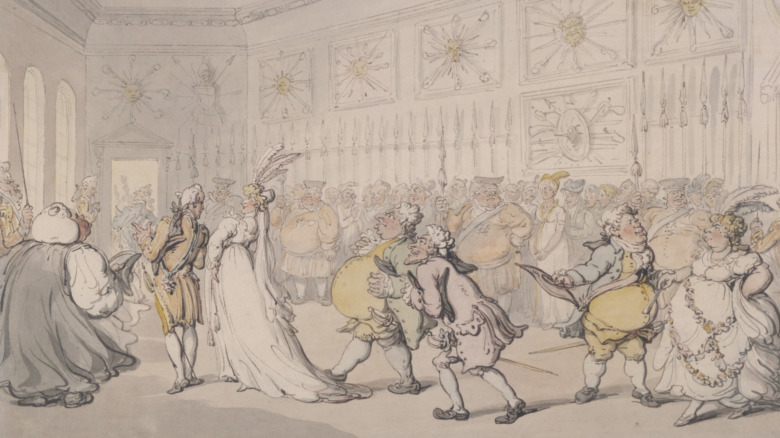The Messed Up History Of Being A Lady-In-Waiting
If you've ever wondered what it was like to hang out with a queen all day, every day, you might not have thought of it as deeply and disturbingly stressful. According to Portland State University, being a lady-in-waiting involved serving the queen in ways related to companionship. They were expected to play music, read books aloud, dance in the queen's bed chambers, design fabulous clothes, and display manners that would prompt any man to melt into the carpet.
However, even in a palace, times can get tough in between breakfast and walks through the courtyard. If we've learned anything from "Game of Thrones," "The Tudors," or even celebrity gossip, it's that the rich and beautiful always have problems. Inspiration for all that debauchery had to come from some where, after all, and for centuries, ladies-in-waiting across the world put up with plenty, and not just death-defyingly snug girdles. Per Tudor Times, they faced everything from the possibility of getting poop on their gowns to the serious concern of having their heads chopped off.
Ladies-in-waiting weren't always paid for their services
Ladies who waited part-time weren't usually paid for their services, while those who were always with the queen were given some sort of compensation. Sometimes they were recouped for their clothing, travel, and food on top of a salary, which certainly incentivized the girls to stay at the job longer, according to Portland State University. This was also one of the only opportunities for women to have serious employment, particularly during the 16th century.
During the Tudor period, being a lady-in-waiting was essentially one of the only careers you could have as a noblewoman. Girls were usually allowed to start their service to the queen, or other royals, at around 16 years old, per Tudor Times. During this time, boys also served high-ranking members of society, as it was expected for everyone to have some sort of experience in assisting others. Women who weren't provided with an allowance from their already wealthy households were given room and board, along with meals and travel expenses. It wasn't such a bad gig ... except if one was working for Queen Elizabeth I, who felt the highest-ranking ladies had enough political power that it was more than sufficient payment in and of itself, according to Elizabethan Era.
Some ladies-in-waiting were waiting for something else...
While in Europe, ladies-in-waiting may have fulfilled certain favors to the king in secret, Japan was totally out in the open about it. The women of the sovereign were certainly known to be of service to the emperor but also fulfilled the usual duties to the empress, which included washing, dressing, and performing other everyday tasks for her, along with keeping her constantly entertained, per Maclean's.
Another advantage to being open about their list of to-do's came when it so happened that their empress was unable to produce an heir to the throne. They were also expected to fulfill that chore for her as well, which was actually considered a great honor. This was the case for the empress dowager during the late 19th century, who chose her top-ranking maid to mother the next emperor. She did so by giving birth to Emperor Taisho, along with two other children from the emperor. And Emperor Meiji assuredly didn't stop with the first maid after he had a successor (and a backup, for that matter) in place. He also had eight children with Lady Sono, another high-ranking and quite attractive maid of the empress.
The Queen Always Comes First
In some cases, maids were expected to serve the queen for life, even if they had made a life for themselves. This was usually the case if they were exceptional and had proven their trustworthiness, kind of like other jobs. As a former lady-in-waiting to Catherine of Aragon (before convincing her husband Henry VIII to leave her), Anne Boleyn expected the utmost attention from her maids. Eleanor Paston, one of her career ladies-in-waiting, maintained her post through four of Henry VIII's marriages while having 11 children, according to Tudor Place.
Meanwhile, in France during the 18th century, Marie Antoinette had found herself a true BFF, Marie-Louise Thérèse of Savoy-Carignan, who was usually at her lady's side 24/7. But when she was away taking care of her dying father-in-law, stuff had really hit the fan for Marie Antoinette in the wake of the French Revolution. Marie-Louise was demanded back to the queen's service without any extended leave thereafter, according to The History Buff.
Inevitably, a mob of angry revolutionaries seized Marie-Louise. After imprisoning her for a time, they demanded that she denounce the actions of the greedy government, but she didn't. So, she was promptly taken into the streets, stabbed to death, and decapitated. And to add insult to injury, the mob put her head on a pike and paraded it beneath Marie Antoinette's windows.
Ladies-in-waiting were expected to get those pretty little hands dirty
Royal women, no matter the continent and country they were from, were not expected to do a single thing for themselves. We all know their attendants were expected to cut their meat and drink their poisoned wine, but they weren't even trusted to wipe their own bums. Ew, but to be fair, their clothing made it pretty impossible to clean up without help, according to History Extra. This particular task was usually reserved for the younger, low-ranking ladies who literally had to get their hands dirty to earn their keep around the palace. But surprisingly, because the tasks in the toilet were so intimate, they were actually considered an honor among palace folks, per Tudor Times.
Ladies in Japan were required to always serve the empress on their knees, even while cleaning her in the lavatory, per Maclean's. This sometimes got a little complicated, if not messy, and there were strict protocols in place to send away for "purification" if they accidentally touched themselves during the stool removal. King Henry VIII's second wife Anne Boleyn took things to another level at her coronation when she wouldn't even hold her own handkerchief if she needed to spit, according to British History Online.
Ladies were also there to appease the king's court, or the king himself
Many are probably aware of King Henry VIII's playboy tendencies, especially with his queen's ladies-in-waiting, and Anne Boleyn was just the start! After executing her for adultery (oh the irony!), he moved down the chain of maids to Jane Seymour and later Catherine Howard and Catherine Parras, per Historyplex. In the early 20th century, Queen Alexandra purposely chose less attractive ladies due to her husband King Edward VII's womanizing ways, according to The Spectator.
King Charles II of Scotland also found himself so enamored with one of his mistresses that he actually made his wife Catherine take her on as a lady-in-waiting to have her around more often, according to Historic UK. It was also known that the king's courtiers were welcome to pursue the maids, and the court essentially became, well, a place to court prospective wives from the upper echelons of society.
A slipup as a lady-in-waiting could mean a beheading later as a Queen
When Henry VIII took his fourth wife, Catherine Howard, she was around 17 years old and a former lady-in-waiting to his previous queen, Anne of Cleves, per Historic Royal Palaces. When the king took the teenager to the altar, he was unaware that she had gotten around a little bit before him. Despite the king's countless, well-advertised affairs, this was a big fat no-no during Tudor times, as women who were eligible for royalty were required to be virgins.
Unfortunately, Catherine was also having an affair with one of the king's close friends, Thomas Culpepper, while she was married, according to Britannica. This damningly tragic secret wasn't kept for long, and the king was quick to revert to his past tactics of dealing with wives who had greatly disappointed him or whom he'd grown tired of. Catherine probably wasn't too surprised when she learned that she'd be executed, considering that her husband had beheaded Anne Boleyn on likely bogus rumors of adultery, treason, and incest.
As for Culpepper, Catherine implicated him with a heartfelt letter she sent him while he was away, scribing straightforwardly, "...when I think again that you shall depart from me again it makes my heart die to think what fortune I have that I cannot be always in your company."
Ladies-in-waiting couldn't wed without the queen's permission
Most probably remember Queen Elizabeth I's nickname, "The Virgin Queen," since she never married. Even if that nickname wasn't true whatsoever, she seemed to have the same expectation for her ladies-in-waiting and seldom gave them permission to marry if she didn't fancy the fellas her maids presented her, per University of Portland. One of Elizabeth's top-ranking ladies, Bess of Hardwick, was imprisoned after not telling her about a marriage of one of her friends' daughters.
Before it seems like that's totally petty and incredibly controlling — the bride in question, Lady Catherine Grey, was next in succession to Queen Elizabeth I, according to Encyclopedia.com. So understandably, it was in Elizabeth's best interest for Catherine to not be married in case she went and did something crazy with her husband, like produce an heir to take Elizabeth's place. So Elizabeth threw the newlyweds in prison along with Bess, who got to spend seven months in the Tower of London.
A lady's every move was controlled
King Henry VIII's first wife, Catherine of Aragon, was a little contradictory with her lot of ladies: She wanted them to be as beautiful as humanly possible but also pious beyond humanly possible, per H for History. This seemed to be the case with all of Henry's wives, however, which makes sense, as almost all of them after Catherine had been ladies-in-waiting to his queens. His second queen was Anne Boleyn, who had refused to be Henry's mistress before he gave up, got an illegitimate annulment to Catherine, and married her.
Knowing how her royal bae could be, Anne had all of her maids carry around a book of prayers and kept them busy sewing for hours on end. And because this was a time in which women were expected to be seen and hot heard, the majority of their days were spent making elaborate garments for themselves, their family, and the king and queen, according to Tudor Times. And if that doesn't really seem too controlling, in the 18th century, members of the English court weren't even allowed to excuse themselves for a pee break without permission. So, on occasion, a girl would simply have to relieve herself right on the palace floor, possibly hoping her dress was big enough to hide the puddle, per The Spectator.
Sometimes a lady-in-waiting had to wait to catch a queen's hands
Later in her life, Queen Elizabeth I was known to be quite temperamental and brutally sarcastic with just about everyone around her, according to The Spectator. Being that her ladies were literally waiting on her, including as a means of entertainment, ol' Lizzy was known to throw some pretty debilitating jabs at them, sometimes literally.
One of her attendants had asked Elizabeth for permission to hitch a widower she had the hots for. Elizabeth denied the woman her blessing, but the couple eloped anyway. So when the queen found out, she was mad and broke the lady's finger with a hairbrush and later blamed it on a falling candlestick, according to The Anne Boleyn Files. When another maid made the mistake of offending the queen when making a joke, Elizabeth promptly sliced her hand with a knife, and that incident didn't seem to come with a royal excuse afterward, according to A Historian's History of the World.
It was known that the queen was also quite depressed toward the end of her life, and while she lashed out at her attendants from time to time, she deeply depended on them to keep her stable and became more needy for their company. As her closest ladies-in-waiting started to die, Elizabeth did, too.
Their purpose was to make the queen look good by also looking good
Ladies of the court had to have it all: musical talent, good wit, exceptional manners, housekeeping skills even if they weren't using them, a highly respectable socioeconomic status, modesty with a touch of sumptuousness then followed by the irony of virginity, and most importantly, genetically superior good looks, per Tudor Times.
This was so imperative that England's King Henry VII had told his wife Catherine to step it up with her ladies she'd brought with her from Spain. He expressed that he needed them to be good-looking for court's sake, and perhaps he wasn't entirely lying. Marriages in the palace were certainly a political affair during the time, and if the court looked good, the royals did, too, according to Portland State University.
Looks had become so important in the 16th century in English courts that Henry VIII's first queen, Catherine of Aragon, went as far to bend the rules for beautiful women who weren't from families of great wealth and nobility, per H for History. Henry's third wife, Jane Seymour, was so superficial that she required her maids to wear extremely elaborate garments, to the point where she came up with standards that included the number of pearls that had to be on the girdle.
Having a lady-in-waiting was a great opportunity to spy
Catherine de' Medici, France's queen during the mid-1500s, had learned very quickly that her husband's mistress was more than just a tight competition to establish power — she had complete control over him, per All That's Interesting. And since sexuality was the easiest and most effective way to become close with the king's court, she assembled a team of 80 attendants who were so gorgeous that they became the puppeteers of Henry II in no time. Their tactics proved to be so effective at gaining Catherine control and political influence that they later became known as the "Flying Squadron" as they relentlessly seduced and manipulated nobles from across Europe, according to the Girl Museum.
Catherine was so ruthless that when her daughter married France's next king, Henry of Navarre, she hired a maid, Charlotte, to start an affair with her son-in-law to gain information, per Women of Power. She then sent Charlotte after her youngest son, who was good friends with the king, so they would be poisoned against one another and would spend their time fighting over Charlotte rather than conspiring together for political gains, according to a biography of Catherine de Medici. But god forbid if any of them became pregnant from their duties to the queen, who immediately banished women who happened to reap the consequences in the proverbial line of fire.
The king's courtiers used ladies-in-waiting to up their social status
A lot more was expected from ladies-in-waiting than the king's courtiers, who were basically just required to have at least some notable relative in society and a skill that would serve the king in some way or another, per the Château de Versailles. And since coverture — women being legally deemed as property — was still very much a thing for monarchs and society in general across Europe and beyond, finding a husband was pretty darn important for ladies-in-waiting, per Iowa Research Online.
This made the girls great pawns for the men at court who were looking to find higher status, nobility, and money, unless the king got to them first, of course, per The Spectator. For the fathers of the maids, their hopes were certainly the other way around, and they sought to set their daughters up for success to find rich, noble husbands at the palace. However, sometimes the queen got in the way of betrothals, especially for exceptional maids that she wanted all to herself, like the fabulously single Queen Elizabeth I, who always sported an impressive squad of girls throughout her reign.
